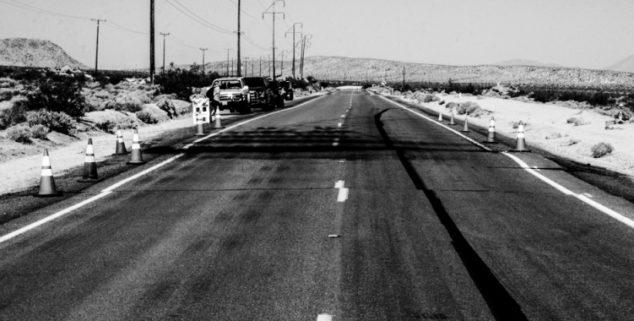News
China Lake: When a quake hits a secret area
 A highway fracture caused by the Ridgecrest quake and aftershock in early July. (Photo: Nick Sklias, via Shutterstock)
A highway fracture caused by the Ridgecrest quake and aftershock in early July. (Photo: Nick Sklias, via Shutterstock) Damaged buildings, torn up roads and water lines and multiple aftershocks are among the challenges residents of the Ridgecrest area are dealing with following two big earthquakes beginning July 4.
The epicenter of the quakes was the Naval Weapons Air Station at China Lake, which does research into military weapons in the Mojave Desert. Because of the secret nature of its work, the state Seismic Safety Commission has been unable to go in and check out what is happening, said Commission Chairman Mike Gardner.
The state’s seismic safety commission is an advisory body to the governor and Legislature with no regulatory ability.
The shaking started on Independence Day with a 6.4 earthquake, followed by a much larger 7.1 earthquake the next day. There have been repeated aftershocks since, including most recently a magnitude 4.2 temblor on Monday at 1:38 a.m.
“They have allowed limited access to geologists but with escorts,” he said. “They are the largest employer in the area — roughly 5,000 people are employed on the base and many of those are civilian contractors.”
The state’s Seismic Safety Commission is an advisory body to the governor and legislature with no regulatory ability. The 15 members include representatives from local government, social services, public utilities, the assembly and the senate.
In a statement posted on the naval base’s Facebook page Sunday, July 14, Capt. Paul Dale, the base’s commanding officer, said the base is gradually bringing back more personnel. In the meantime, the base is offering telecommuting options where appropriate as well as temporary work at other locations, the statement said.
“There was less visible damage than I would have expected and most professionals would expect.” — Mike Gardner.
“A balance exists between number of personnel performing duties on the installation and the infrastructure, facilities and service capabilities able to absorb those personnel performing duties – we must maintain that equilibrium to keep recovery operations functioning at the highest level,” Dale said in the statement.
At least six homes on base were unable to be occupied because of burst water line damage. Richmond Elementary School on the base faced significant damage to its ceiling, walls and floors.
Gardner said other damage in the area included interior roof failure at a couple of supermarkets in the area and at a movie theater complex. But he said the overall view wasn’t as bad as he was prepared for.
“There was less visible damage than I would have expected and most professionals would expect,” Gardner said. “It’s not concentrated. There’s not a block with a lot of damage and two blocks over with less. We don’t know for sure why that it is.”
“They think the aftershocks are over. They aren’t. We definitely want people to stay on their toes.” — Susan Hough
Other damage included cracking of Highway 178 and a nearby water line, leaving residents of the nearby town Trona without water and access to a grocery store for several days. It was a 20-mile drive past roads ruptured by the quake to get to the nearest grocery store that was open. Churches banded together to help those without cars get food and water, Gardner said.
Susan Hough, a seismologist who serves as the Southern California earthquake response coordinator for the U.S. Geological Survey, said it has been more than 20 years since there has been an earthquake of a similar magnitude in the region. “It’s been blissfully quiet,” she said. “We knew it was not going to last forever.”
It isn’t done, either. Hough said aftershocks will likely continue for years but most of them will probably be small. “It always surprises people,” she said. “They think the aftershocks are over. They aren’t. We definitely want people to stay on their toes.”
The San Andreas fault is the sliding boundary between the Pacific Plate and the North American Plate cuts the state in two.
The damage is not as extensive as it could be because the quakes hit in an area with low population. Ridgecrest has about 28,000 residents and Trona has less than 2,000. There would have been a lot more impact if the quakes had taken place in the Bay Area, for instance, Hough said.
What’s interesting is that the biggest fault in the area — the San Andreas — has remained quiet. “The San Andreas is the main player but the supporting players have had some big scenes lately,” she said.
The San Andreas fault is the sliding boundary between the Pacific Plate and the North American Plate cuts the state in two. San Diego, LA and Big Sur are on the Pacific Plate while San Francisco, Sacramento and the Sierra Nevada are on the North American Plate.
Tom Rockwell, a San Diego State paleoseismologist, said an earthquake on the San Andreas fault is long overdue. He compared it to when a stick is bent and you hear cracking in the weak spots before the main break occurs.
“It feels like we’re having a lot of moderate to very large activity on very minor faults leading up to something,” he said.
Want to see more stories like this? Sign up for The Roundup, the free daily newsletter about California politics from the editors of Capitol Weekly. Stay up to date on the news you need to know.
Sign up below, then look for a confirmation email in your inbox.

Leave a Reply